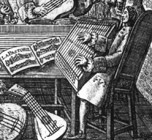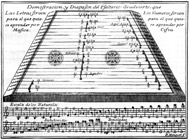
CHAPTER 3: History to 1800
3.5 The Baroque, Rococo and Classical Periods 1600-1800
3.5.1 The west
1.2. Higher cultures in the 17th & 18th centuries: Romance language-area
Documentary evidence: 7 of 14
[140]
click! |
click! |
The engraving is clearly not intended to give exact reproductions of the instruments - the harp has only 14 strings, and the keyboard instrument recalls the 15th century more than the 18th but the artist has been consistent in showing half as many strings as tuning pegs on the guitar-family instruments, which presumably had double courses: fifteen single strings are shown, and hitch-pins in pairs are suggested, so that the instrument may be intended to show 15 II strings: as mentioned above, no such instrument exists at this time, although 15 courses is perfectly likely.
click! |
Anthony Baines suggests that the tune has the characteristics of an Italian saltarello which, as a folk dance, could well warrant Minguet's label 'Pastoril'. It would be lovely to postulate a reconstruction, with melody played by flute, recorder, violin and salterio and a continuo section of harp, guitar and harpsichord: but regretfully one must consider that the artist was probably only indicating the instruments dealt with in the tutor, or those generally current at the time.
The indication of continuous bridges divided into several parts to vary the ratio across the bridge is clear. The placing of the instrument on a table is convincing enough, although it may have been rare for it to share the surface with a clavier.
click! |
It creates a very human touch that the two sound-holes are evidently scribed with some kind of tool that makes circles and arcs, without any attempt to modify them to fit the perspective which the drawing otherwise uses ...
[2008] Five years after this study was written, Messrs. Minkoff published the whole work in facsimile, so then it was posssible to get to know the whole work. The Psalterio is listed on the title page, as the eighth of 14 instruments, before even the violin, flute and recorder.
Apart from the main title page for the whole collection, there are separate title pages for six sections within the book, evidently so that the smaller sections could be bound and sold separately: they can also have been made at different times
Only the sections for the Psalterio and the flutes are dated, both 1754: they might be later additions.
The Psalterio section consists of five pages of text, the tuning diagram and one page with three melodies, 'Minue', 'Pasapie' and 'El Amable'.
Of the three melodies, the first two are given in both staff notation ("para ... aprender por Musica") and tablature ("para ... aprender por cifra"), though there was no room for the tablature version of the third. All three tunes include chords with two and three notes to fill out the harmonies: all three are also given in the guitar section, as single-line melodies without extra notes, so we can be sure which is he meolody and a comparison with the other versions shows that in the first two, the extra notes are all under the melody; but that in El Amable, the extra notes are added above the tune as well as below it, an effect which may be familiar from the sound of the baroque guitar and theorbo. Or even the five-string banjo.
A translation of the text of this extraordinarily detailed and practical work will follow as soon as time allows, but for now here are the topics of the nine reglas:
Regla
primera: what the psalterio is, and what it's composed
of: Regla segunda: stringing Regla tercera: learning by notes Regla quarta: writing the notes on a bit of paper under the strings |
Regla quinta: tuning Regla sexta: playing, with detailed notes about which fingers and thumbs to use to play particular examples of two and three notes at the same time Regla septima & octava: transcribing the notes to tablature Regla general de acompañar: adding harmonies |
|
|